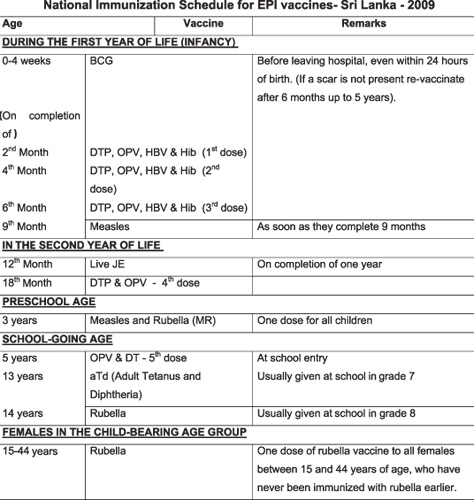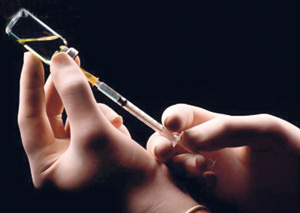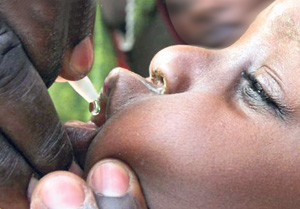Twenty million felled by smallpox, two million by polio and six million by measles! This was not so long ago, with the victims of smallpox, polio and other “killer” communicable diseases including men, women and children across the globe.
Zero cases of smallpox in 1977 just over 1,500 cases per year of polio in 2006, measles deaths drop to 200,000 in 2008 and on average over one million deaths per year averted due to pertussis, diphtheria, tetanus and some other diseases.
What is the “miracle” that cut death rates drastically even though germs which spread these killer diseases are all around us still?
Vaccinations, stresses Epidemiologist Dr. Sudath Peiris of the Epidemiology Unit of the Health Ministry, explaining that this “modern medical intervention” has been the key contributory factor in bringing down death rates and increasing life expectancy.
The germs or causative organisms of some of these diseases have not been eliminated or eradicated but the success both globally and locally of the immunization programmes in the past 30-40 years has prevented people including children from dying, he says. “When we do eliminate and eradicate the causative organism such as the one which spreads smallpox, we can stop the vaccination of people against it.”
Ten childhood killer diseases have been kept at bay through the very successful National Immunization Programme (See box for details) implemented by the Health Ministry through the Epidemiology Unit. The programme has been established by a panel of experts, the National Advisory Committee on Communicable Diseases, appointed by the Director-General of Health Services, and is based on international guidelines set by the World Health Organization and Sri Lanka’s requirements.
The programme covers childhood Tuberculosis, Polio, Diphtheria, Tetanus, Pertussis (whooping cough), Hepatitis B, Haemophilus influenzae type B (HiB), Measles, Rubella and Japanese Encephalitis (JE). (See box for disease descriptions)
Under the programme, a child needs to get one dose of BCG against childhood TB, six doses each of diphtheria, tetanus and pertussis, five doses of oral polio, two doses each of measles and rubella, three doses each of Hep B and HiB and one dose of JE, explains Dr. Peiris.
Why is it crucial to complete the schedule?
The number of doses will vary as the purpose of vaccination is to create antigens, says Dr. Peiris. Citing the example of nature, he points out that if someone gets a certain disease once, that person may develop life-long immunity against it.
In the case of vaccination programmes, such diseases may need only one or two doses to acquire life-long immunity but others several doses, he says.
It depends on the virulence of the organism, MediScene understands. If the virulence is high the person needs less exposure, may be one, to get immunity but if the virulence is low then repeated exposures.
The immunity development mechanism is also different between live and killed vaccines, according to Dr. Peiris. “Live vaccines create infection and develop immunity as in the case of natural infections and last longer.
However, vaccine efficacy of live oral vaccines is very low and needs repeated doses compared to live injectable vaccines. Killed vaccines also need repeated doses to boost antibody levels.”
Cautioning against stopping the vaccinations half-way, Dr. Peiris says some parents are keen to get the immunization jabs only in the first year for their children, but the enthusiasm wanes after that.
As both parents and health workers have not seen the deadly results of these diseases in recent times due to no clinical specimens being available after successful immunization campaigns, they may think it is not important to vaccinate children, he says, adding, “this should not happen.”
Meanwhile, like any other pharmaceutical product or medical procedure such as surgery, vaccinations are not without some risks, MediScene learns.
There could be “vaccine reactions” which in a majority of patients would be very mild such as pain and swelling, redness at the site or fever in the first and second day. Rarely, severe reactions such as convulsions and very rarely, severe allergies may cause anaphylactic shock as experienced recently against the rubella vaccines, says Dr. Peiris.
The most important thing is to take into account the fact that the benefits far outweigh the risks heavily, he says, pointing out that before vaccinations as many as 30,000-50,000 children died annually of these 10 diseases in Sri Lanka.
Top 10 killers
Diphtheria is an infectious disease caused by the bacterium Corynebacterium diphtheriae which primarily affects the mucous membranes of the respiratory tract (respiratory diphtheria). It usually affects the tonsils, pharynx, larynx and occasionally the skin (cutaneous diphtheria). It may also cause complications in the form of diphtheritic myocarditis (toxic damage to heart muscles) and neuritis (toxic damage to peripheral nerves). The disease can be fatal. Vaccination -- DTP
Hepatitis B is a viral infection that attacks the liver and can cause both acute and chronic disease. The virus is transmitted through contact with the blood or other body fluids of an infected person. If chronically infected during childhood, adults can die from liver cancer or cirrhosis (scarring of the liver). Vaccination – HBV
Haemophilus influenzae type B (HiB) is a bacterium which causes meningitis and pneumonia which could result in death, with children under five, especially between four and 18 months, being vulnerable. Contrary to what the name suggests, the bacterium does not cause influenza. Vaccination -- HiB
Japanese encephalitis is a mosquito-borne viral infection which leads to brain swelling and damage. Vaccination -- JE
Measles is a highly contagious, serious disease caused by a virus in the paramyxovirus family which grows in the cells that line the back of the throat and lungs. It is one of the leading causes of death among children. Vaccination -- Measles
Pertussis or whooping cough is a disease of the respiratory tract caused by bacteria that live in the mouth, nose and throat. This disease which is most dangerous in infants causes severe coughing spells. Vaccination -- DTP
Polio or poliomyelitis is a highly contagious viral infection that can lead to irreversible paralysis (usually in the legs), breathing problems or even death. The virus enters the body through the mouth and multiplies in the intestine and then invades the nervous system, causing paralysis within a matter of days. Vaccination – OPV (oral polio drops)
Rubella caused by a virus is spread in airborne droplets when infected people sneeze or cough. Even though it is a mild childhood illness, if an expectant mother contracts the disease, she can pass it on to her baby causing Congenital Rubella Syndrome (CRS) which results in the baby’s death or severe birth defects with deafness being the most common. CRS can also cause defects in the eyes, heart and brain. Vaccination -- Rubella
Tetanus also known as lockjaw is a serious disease caused by the bacterium Clostridium tetani that affects the body’s muscles and nerves. It typically arises from a skin wound that becomes contaminated by the bacterium. Vaccination – DTP
Childhood tuberculosis (TB) is a serious infection caused by the bacterium Mycobacterium tuberculosis. Although pulmonary (lung) disease is the predominant outcome, it could affect any organ by spreading through lymph and blood. In children hematogenous spread could result in severe disease including miliary TB (affecting organs such as the liver and spleen) and TB meningitis (affecting the brain). Vaccination – BCG (Bacillus Calmette-Guerin)

|




